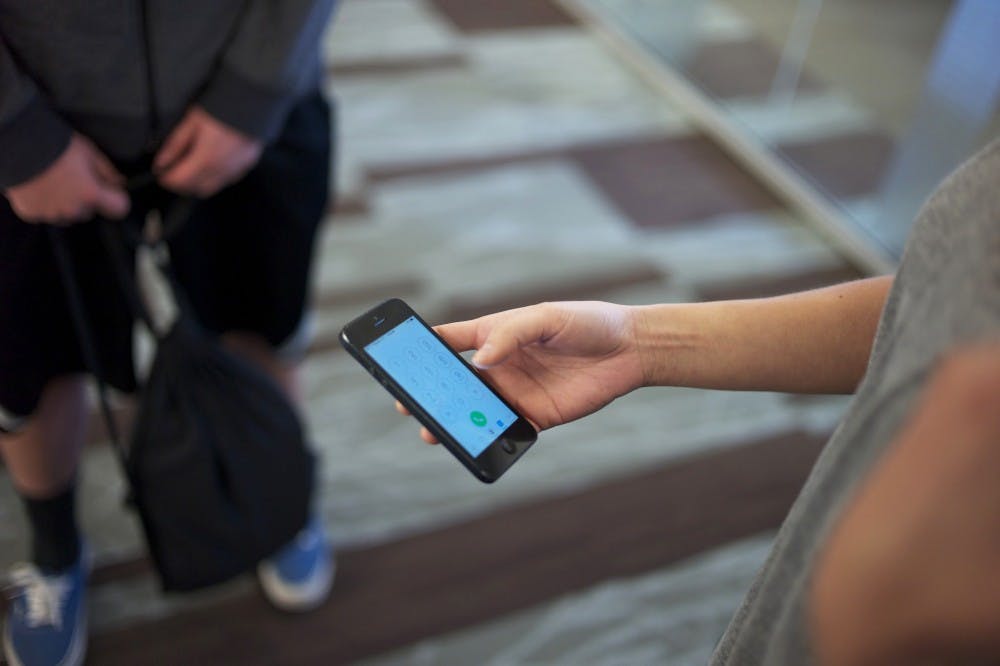Jacob Fuhrer |
If you’ve relied on spotty cell phone coverage as an excuse for not calling your parents, the jig is almost up. The notoriously poor cell phone service on campus is about to get a big boost thanks to a network of antennas that will soon be installed on The Bluff.
The small, smoke detector-shaped antennas, collectively called a distributed antenna system (DAS), will be placed around campus to provide cell coverage in areas where signals have difficulty reaching.
Michelle Sunderland, director of Technical Services, said the project is a response to complaints from students.
“We’re very much aware there are quality of service issues on campus,” Sunderland said.
UP has teamed up with Anthem Telecom, which is negotiating with all four major cell carriers to hook up to the DAS. Information Services expects at least two carriers to sign onto the DAS and agree to foot the bill, after which the system can be installed over the summer.
The project will happen in stages, and it’s unclear yet which buildings on campus will be first to get improved coverage. However, Sunderland emphasized the importance of communications in residence hall.
“We’re very concerned about the dorms because that’s where our students reside, and they want to have good service where they live,” Sunderland said. “The end goal is to have that full coverage through all the buildings.”
In an age when people can’t go a day without cellphones, DAS is becoming an increasingly popular choice to bring coverage and speed to users. Sunderland said Anthem Telecom constructed a similar antenna system at Nike’s headquarters in Beaverton and was able to bring the system online in a matter of months.
In addition to the antenna system, Sunderland said the University has reached an agreement with Verizon Wireless allowing the company to place a cell site on top of Mehling Hall.
“That’s sweet,” freshman Heather Neace said when she heard the news. “Especially since I drop calls all the time in Mehling too.”
Neace is a Verizon customer and recalled a time when she dropped a single call with her parents more than three times.
“It’s super annoying,” Neace said.
Sunderland said the new Verizon antennas will not change the appearance of the building and that the antenna can be made to match the surroundings.
For Patricia Rincon, a senior communication major, it’s about more than keeping in touch with family.
“Yesterday my third class was canceled and I had no idea because I had no service,” Rincon said. “It would have been great to know before walking over there.”
Rincon says school wifi does help a bit, but even that can be flaky.
AT&T and T-Mobile already have communications equipment on Swindells Hall and Buckley Center, respectively.
Adam Haas, principal of Converge Communications, a telecommunications consulting firm, said the new antennas are consistent with an industry-wide trend.
“The demand (for service) is going to keep increasing exponentially,” Haas said. “The big issue is cell providers need to do more and more installations, just to be able to keep up with demand.”
Haas also said the installations can be a good revenue source for the school. Indeed, Sunderland said Verizon will likely pay a recurring fee to the University for hosting equipment on Mehling.
In addition to making service easier to access for students, the system will also improve Public Safety radios. Sunderland’s office is working with Public Safety to coordinate which areas are in need of improved reception.
If all goes well, both the DAS and Verizon tower will be constructed over the summer.
“We’re fully committed to providing this service to our students, faculty and staff and we’re excited to have taken this first step,” Sunderland said.
Jacob Fuhrer is a reporter for The Beacon. He can be reached at fuhrer17@up.edu or on twitter @jacobfuhrer.








